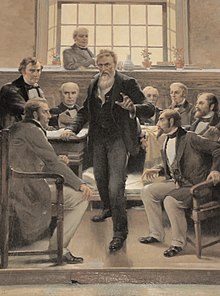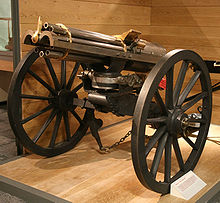Introduction to US History/Civil War
| Resource type: this resource contains a lecture or lecture notes. |
Background
[edit | edit source]Slavery in the "Antebellum South", a term used for the Southern portion of the United States from after the War of 1812 and before the civil war, continued to illegally import thousands of slaves despite the US Constitution forbiding such pratice (Article 1, Section IX). African Americans who escaped to the North were still fearful of being caught and sent back to their owners.

In 1859, almost 250,000+ free blacks lived in North. Although they were free, they didn't enjoy the same priveleges as their white counterparts:
- They were forbidden to work in specific occupations
- They were prohibited from testifying in court vs. white people
- Couldn't vote
- Couldn't attend public school
- Some states did not allow blacks to cross their boundaries
Although there were free blacks in the North, there were also free blacks in the South. They either got their freedom by being freed by their owners, being freed by their fathers (mulatto), purchased it, or ran away. Some even became wealthy and owned slaves themselves, as in the case of businessman William Johnson Natchez. Blacks owning slaves isn't an unheard thing in the US at this time.
Abolitionists & Slaves Take a Stand
[edit | edit source]A number of abolitionists, people who advocated for the ending of slavery, made sure they made their mark in history.
- Harriet Beecher Stowe was a white American author who wrote Uncle Tom's Cabin, which detailed the hardships that slaves had to endure.
- Frederick Douglas was a former slave who spoke out against slavery on a large platform. He was a skilled author, writing the autobiography, Narrative of the Life of Frederick Douglass, an American Slave.
These movements installed confidence in the slaves themselves. Some slaves were determined to help their fellow slaves attain freedom.
- Harriet Tubman was an American slave who is best known for the creation of the Underground Railroad. The Underground Railroad was a series of safehouses/checkpoints, managed by abolitionists, which assisted runaway slaves towards land that would grant them their freedom.
- Nat Turner was an American slave who led a rebellion in August 1831. Turner felt that he had a "special sign" to do this rebellion earlier in the year by a solar eclipse. On August 21, 1831, Turner and his 70 men raided every home they could find in Virginia and slaughtered all the white people they saw. They killed about 60 people until the state militia put them down. He escaped capture for 6 weeks until he was finally captured, tried, and hung for his crimes.

- John Brown, who interacted with both Tubman and Douglas, was an abolitionist who played a part in the "Bleeding Kansas" violent altercations and led the raid in Harper's Ferry, Virginia in October 1859. John Brown planned to break in and steal military weapons from an arsenal in Harper's Ferry, give them to the runaway slaves, and move southwestward and create new territory - which would eventually be admitted into the Union as a free state. Instead, 20 heavily armed men arrived in VA and successfully broke into the arsenal and cut off communications (to spread the news of the rebellion). But, they were trapped in the armory for 32 hours by the local militia. Eventually, the door was kicked down and Brown was arrested by Colonel Robert E. Lee. He was tried and executed in December 1859. He was seen as a "martyr" in the eyes of the North and a "traitor" by the eyes of the South.
Succeeding the Union
[edit | edit source]1860 Presidential Elections
[edit | edit source]Candidates included:
- (RP) Abraham Lincoln representing the Republican party
- (D) Stephen Douglas representing the Democrats and abolitionists
- (D) John Breckinridge representing the Democrats and pro-slavery people
- (CU) John Bell representing a mix of politicia.
Lincoln and his Republican party went against all of the South's interest. He did not promise slavery extensions, promised an increase in tariffs, civil rights protection for immigrants and to build a Transcontinental railroad for CA and OR. As a result, the South said they would secede the Union if Lincoln is elected. As a result, Lincoln recieved <40% of the Union's vote - but he won the elections through the electoral vote.
South Secedes
[edit | edit source]The South panics even though they didn't need to. The Republicans didn't control Congress and pro-Southerners made up the majority of SC judges. Nonetheless, South Carolina secedes from the Union a month after the election. This is effectively a domino effect.
Lincoln's inauguration took place in March 1861, which surely would've given Buchanan time to do something about the seceding South? Nope, he does nothing whatsoever! Congress places inauguration in January instead of March as a result. Buchanan believed that the South couldn't legally secede, the Constitution didn't forbide it, and he had no authority in preventing it. While Buchanan sits and does nothing, the South take over the following cities/significant locations.
- Federal arsenals
- Fort Monroe, Chesapeake Bay
- The New Orleans mint
- Customs House, Charleston, SC
Daniel Webster and Henry Clay are dead by this point, so no one was able to successfully compromise with the South!
The Civil War
[edit | edit source]Major Figures
[edit | edit source]Robert E. Lee comes from a historical background. His father, Harry Lee, fought in the revolution and signed the Declaration of Independence. Lee was an outstanding student at the prestigious West Point Military Academy and his battle tactics are still being taught in that school to this day. General Ulysses S. Grant also attended the same academy and was dubbed as the "meat grinder" because of his merciless battles.
Some other notable generals are Ambrose Burnside (known for his burnsides), George Hooker ("hooker" = prostitutes), P. G. T. Beauregard (who led the attack on Fort Sumter, starting the civil war), and William T. Sherman (burned Atlanta to the ground).
New Technology
[edit | edit source]
The war was introduced to 19th century weapons with 18th century tactics. Those new weapons include the gatling gun, iron-clad ships, and trench warfare. Digging deep trenches was the only way to escape the gatling gun, which was a forerunner for machine guns. It didn't require precise precision and was deadly against 18th century tactics (such as walking in one, straight line armed with bayonets). This is why we saw thousands of casualties in every battle.
Innovations didn't just take place on land, but also in the waters too. The USS Monitor and the CSS Merrimac changed the ship game for good. Thick steel covered the wooden hulls of the ship so that cannon balls would bounce off of the ship when launched, preventing damage to the hull. In the Battle of the USS Monitor and CSS Merrimac, these two ships went at it on each other for over a day. It results in a draw. The Confederate's Merrimac withdrew from the naval fight and sunk off the coast of North Carolina while the Union's Monitor heads back to New York. The Union navy, in response, imposes a blockade on the South and prevents any other countries from providing naval support.
Hot air balloons was a new warfare tool. They were used to spy on the enemy's position during times of battle. Telegraphs and railroads were new. Military orders were transmitted faster and railroads allowed the fast transportation of soldiers and supplies.
Emancipation Proclamation
[edit | edit source]Battle of Antietam was fought in late 1862 between Confederate general Robert E. Lee and Union general George McClellan. This battle was fought in Maryland, a border state that was forbidden to secede because of its proximity to the capital, Washington DC. The Confederates attempted to invade the North (their first attempt), but failed. It was the bloodiest battle in the entire war, but it gave the "go" for Lincoln to declare the Emancipation Proclamation. In this 1863 order, Lincoln stated that all slaves in the South (states in rebellion with the Union) were free - this didn't apply to border states.
Lincoln intended this proclamation to be the "booster" that the Union needed to here, but this backfired with the 1863 racial riots of New York. Irish-Americans fought with Union soldiers and black people in New York, resulting in 100+ deaths. Here, we see a stark difference. Northern soldiers fought to protect the Union while abolitionists were fighting to end slavery: two different aims. The Northerners feared that the blacks would come to the North and "steal" their jobs away from them + along with the immigrants. African-Americans wouldn't officially be freed until the 13th amendment in 1865.
In June 19, 1865 (Juneteenth) in the city of Galveston, Texas, is when the Emnacipation Proclamation spread out to all southern cities. Union general Gordon Granger led his troops towards Galveston and declared all slaves free. By this point, the 54th Massachusetts Volunteer Infantry Unit will show that several African Americans will be employed in the Union military ever since its training started in 1863.
Turning Point: Gettysburg
[edit | edit source]
The Battle of Gettysburg (1863) was the first depictions of the greusome effects of war and destroys Lee's army in Virginia. By this point, Lincoln runs for re-election in 1864 and wins despite public opinion vs. George McClellan. General Grant captures Chattanooga, Tennessee and General Sherman destroys Atlanta.
The North improves their outlook on Lincoln through his victory at Gettysburg and the captures of Mobile, AL (by General Farraugt) and the Shenandoah Valley (by General Sheridan). The Mississippi River is also captured, splitting the Confederates into two. This is ontop of the capture of several Southern ports by the Union navy.
In Sherman's March to the Sea, Union general Sherman leaves a horrible track in Georgia, leaving nothing behind. He destroys anything in his pathway (including Atlanta, GA) and steals livestock for the Union army.
Siege of Petersburg
[edit | edit source]Despite it not being a classical military-style "siege", Grant initiated the siege of Petersburg. Instead of attacking the "'typical" destination of Richmond, he surprises everyone and attacks the railroad hub, Petersburg. He wanted to prevent the Confederates, including Lee and his army, to escape. Isolating Lee and his troops would keep them away from their president, Jefferson Davis.
Battle of the Crater was a part of the siege between Confederate William Mahone and Union general Ambrose Burnside. This was a poorly executed attack by the Unions as general Burnside was never called up again after this battle, which was a Confederate victory. The Union planned on invading the Confederate fort by blowing out the defense. The fuse ended up exploding at the wrong time and killing over 200 Union soldiers. General Mahone's troops fired back at the invading soldiers and were successful in defending Petersburg for that time being.
Surrender of General Robert E. Lee
[edit | edit source]The final move was the Union invading and capturing Richmond. The Confederates attempted to set the city on fire, but the Union troops put out the flames in the nick of time. In April 1865, Grant was successful in capturing the city and forcing the surrender of General Lee a week afterwards. George McClean's house of the Appomattox Courthouse is the center of the surrender, which hosted a peaceful and compassionate event.
